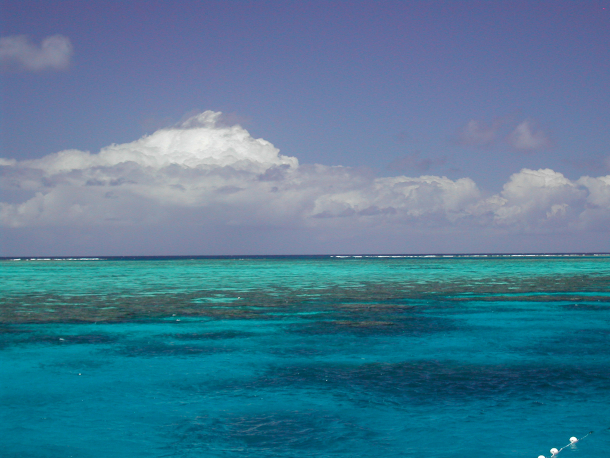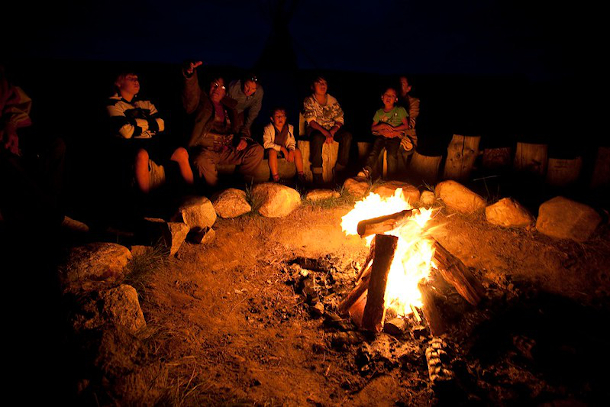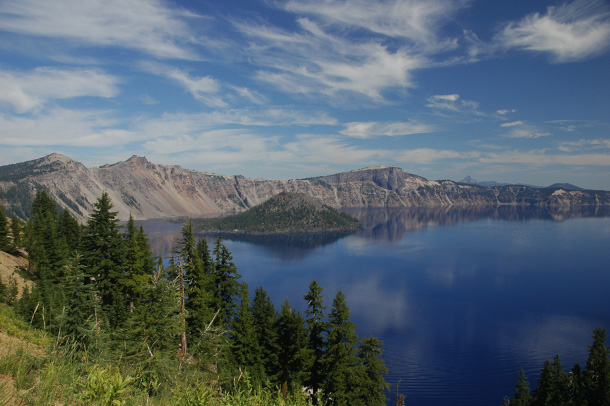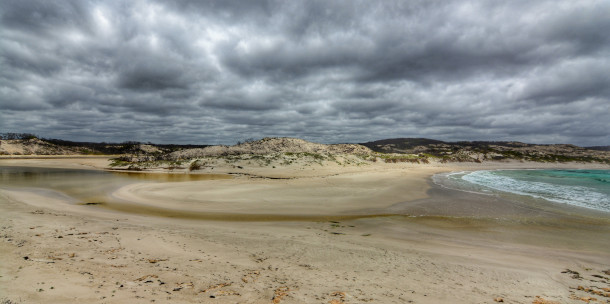Ancient Stories of Sea Level Rise
Air Date: Week of December 9, 2022

The Great Barrier Reef, located off the coast of Queensland, Australia, is the world’s largest coral reef system. (Photo: Pete Edgeler, Flickr, CC BY-NC-ND 2.0)
The seas are rising because of climate change, but this isn’t the first global sea level rise humans have lived through. In fact, some Indigenous peoples have stories of sea level rise that they’ve passed down over thousands of years. Patrick Nunn, a geographer and geologist at the University of the Sunshine Coast in Australia, joins Host Bobby Bascomb to tell us about how oral traditions reflect the environmental changes our ancestors lived through.
Transcript
BASCOMB: Climate change is expected to deliver substantial sea level rise in the coming decades. That will dramatically change coastal areas as we know them, but this isn’t the first global sea level rise humans have lived through. In fact, previous interglacial periods of warming caused dramatic sea level rise worldwide. And many indigenous peoples have stories of sea level rise that they passed down through countless generations, in some cases these stories have persisted for thousands of years. That’s according to research conducted by Patrick Nunn, a geographer and geologist at University of Sunshine Coast in Australia. Welcome to Living on Earth, Patrick.
NUNN: Many thanks. I'm delighted to be here.
BASCOMB: So your research mainly focused in Australia, you collected stories from about 32 Aboriginal groups around the continent. Can you tell us one or two of those stories, please?
NUNN: Well, sure, someone was actually telling me a story the other day that I hadn't heard before. It's the story of some ancestral being named Gunya. And he was living in North East Australia, where the Great Barrier Reef is today. And the Great Barrier Reef at the time was all dry land. Gunya and his people walked across this area, they named different places, they developed associations with different places, most of which are still underwater. But this gentleman was saying to me, well, you know, today, we still recognize that island over there as being the top of the hill. And the story then goes on to talk about how the ocean surface rose and started to gradually flood this huge area of land that is today, the Great Barrier Reef, and it drove the people landward. They suddenly found themselves living together in diverse groups, which they never had before and speaking different languages. And when I first encountered these stories, it became clear to me that they were recalling the rise in the ocean surface that occurred after the last ice age, after the end of the last ice age. So roughly between about 15,000, and in Australia, around 7,000 years ago. Seven thousand years ago was when the ocean surface reached its present level around Australia. And since then, it's been reasonably stable. So it's a story I love because it has a social element to it. It talks about the societal disruption, which accompanied this rise of sea level and that's something you don't find in all of these stories.

For thousands of years, humans have made sense of the world around them through stories. (Photo: Viaje a Canada, Flickr, CC BY-NC-ND 2.0)
BASCOMB: And so for a story to persist for 7,000 years, it's got to be a pretty good story, right? You know, just saying, “Hey, there used to be more water. And now there's not,” that's not gonna stand the test of time very well, I think.
NUNN: What a lot of people think when they hear that the story could have persisted, passed on by word of mouth for more than 300 generations. The problem that a lot of people today have with that kind of suggestion is the word "story." We tend to think of a story as something invented or something entertaining, whereas I think, if you go back 7,000 years, stories were education, they were practical information. And the importance of conveying that information from one generation to the next was all about survival. If you wanted your children and your children's children to survive, they had to know everything that you knew, and your ancestors knew about this changing uncertain world in which they lived. And that, I think, is why those stories were preserved for so long. Because it wasn't an option to learn those stories. It was a requirement.

Crater Lake in Oregon was once home to a large volcano that erupted and collapsed on itself. (Photo: informedmindstravel, Flickr, CC BY-NC-ND 2.0)
BASCOMB: Do you think that these types of stories are more important in a place like Australia? I mean, it's extremely dry. There's some of the world's most toxic and venomous snakes and scorpions and spiders. I mean, everything there is trying to kill you. It's such a harsh environment. Do you think that these types of stories become more important to survivability in a place like Australia?
NUNN: Absolutely, it is because Australia is such a harsh environment, and that water is generally so difficult to find. I think that the indigenous people of Australia, who arrived there probably around 70,000 years ago, and really didn't have a lot of contact with the outside world until European settlers arrived. That isolation, combined with the harshness of the Australian environment, also really gave us a perfect set of circumstances for developing and preserving these kinds of oral traditions.
BASCOMB: Gosh, that's just amazing. It's such an interesting approach to looking at the world. You know, I think a lot of scientists hearing these stories might think “Yeah, yeah, sure, that's a nice story.” But not, you know, take it too seriously. What prompted you, though, to take this seriously and look into it further?
NUNN: So most of my research career I have spent in the Pacific Islands, and in the Pacific Islands, there were and there still are a lot of usually older people who are not literate, who can't read or write, who don't necessarily speak very much English, but nonetheless have a vast amount of information that they store in their heads. And when I first encountered such people, it was a real revelation to me that I think literate people tend to be very dismissive of oral information. If it's not written down, it doesn't have doesn't have value, it doesn't have merit, it doesn't have validity. And this is the problem, I think, because I think many oral societies were sustained by a richness and an integrity of oral information that we've largely forgotten about today.
BASCOMB: And there's actually a term for these kinds of stories. They're called geomyths. Can you give some other examples of geomyths?

Kangaroo Island, located in South Australia, was once connected to Mainland Australia before rising sea levels separated it. (Photo: John Morton, Flickr, CC BY 2.0)
NUNN: There are lots of other geomyths regarding flood myths. And of course, there are a lot of global flood myths as well. My interpretation of this is that these flood myths evolved in different places. When you got flooded once you generated a story or a myth about that flood. When the next flood came along, then you amplified the previous account and amplified the next account, and so on and so on. There are myths in in other parts of the world about earthquakes and about tsunamis. Where Crater Lake in Oregon is today, there used to be a huge volcano, which we've called today, Mount Mazama. And Mount Mazama blew itself to pieces and collapsed about 7,600 years ago. The first Europeans to get into that area spoke to the Native Americans who live there. And they told the stories over and over again, about that volcano collapsing. That story has persisted for 7,600 years, in an oral context. So it's a mistake to think that geology and the earth sciences developed only in the last 150, 200 years or so. There were people trying to explain the origins of the earth and the way that it was, it seemed to be evolving long before people could write things down. And I think geomyth is really digging back into the distant past in the way that we've never done before. So I think it's really exciting.
BASCOMB: Well, it's really fascinating, I must say. What is your takeaway from doing this research in terms of the importance of including this type of indigenous knowledge with scientific inquiry?
NUNN: Today, we are being confronted by climate changes that are more rapid than they have been for several thousand years. They're not unprecedented in the history of humanity. So the rise of sea level that we're experiencing today, and the rise of sea level that is projected to occur over the next 100 years or so, is less than what it was during the period of post-glacial sea level rise. So I think that we can look back into the past and we can unpack our distant ancestors encounters with rising sea level, and learn from what we can discern of their experiences. We can look into the past, and we can realize that our ancestors survive this period of prolonged and rapid climate change. They survived. And that gives us a certainty, I would say, that it's possible to survive this period of climate change. So the sky is not falling. This is not the end of the world, but our ancestors 7,000, 8,000, 10,000 years ago also had to undertake profound adaptations in order to survive.
BASCOMB: Patrick Nunn is a geographer and geologist at the University of the Sunshine Coast in Australia. Patrick, thank you so much for this time today and all of these wonderful stories.
NUNN: Many thanks, Bobby. I've thoroughly enjoyed it.
Links
Scientific American | “Ancient Sea Rise Tale Told Accurately for 10,000 Years”
Living on Earth wants to hear from you!
Living on Earth
62 Calef Highway, Suite 212
Lee, NH 03861
Telephone: 617-287-4121
E-mail: comments@loe.org
Newsletter [Click here]
Donate to Living on Earth!
Living on Earth is an independent media program and relies entirely on contributions from listeners and institutions supporting public service. Please donate now to preserve an independent environmental voice.
NewsletterLiving on Earth offers a weekly delivery of the show's rundown to your mailbox. Sign up for our newsletter today!
 Sailors For The Sea: Be the change you want to sea.
Sailors For The Sea: Be the change you want to sea.
 Creating positive outcomes for future generations.
Creating positive outcomes for future generations.
 Innovating to make the world a better, more sustainable place to live. Listen to the race to 9 billion
Innovating to make the world a better, more sustainable place to live. Listen to the race to 9 billion
 The Grantham Foundation for the Protection of the Environment: Committed to protecting and improving the health of the global environment.
The Grantham Foundation for the Protection of the Environment: Committed to protecting and improving the health of the global environment.
 Contribute to Living on Earth and receive, as our gift to you, an archival print of one of Mark Seth Lender's extraordinary wildlife photographs. Follow the link to see Mark's current collection of photographs.
Contribute to Living on Earth and receive, as our gift to you, an archival print of one of Mark Seth Lender's extraordinary wildlife photographs. Follow the link to see Mark's current collection of photographs.
 Buy a signed copy of Mark Seth Lender's book Smeagull the Seagull & support Living on Earth
Buy a signed copy of Mark Seth Lender's book Smeagull the Seagull & support Living on Earth

